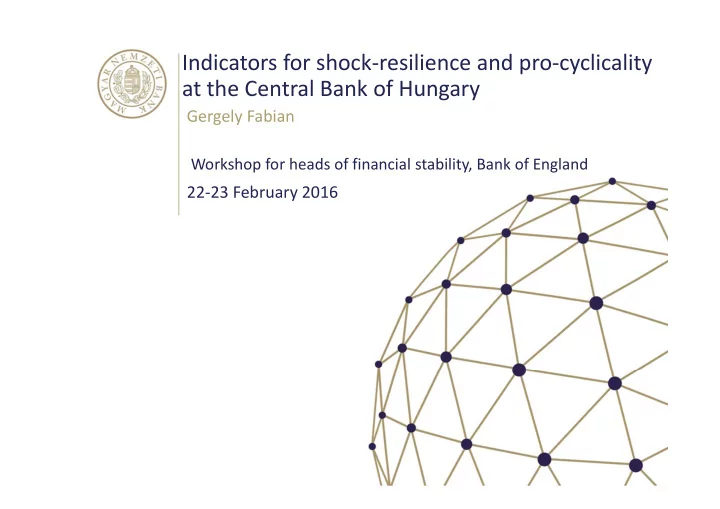

Indicators for shock ‐ resilience and pro ‐ cyclicality at the Central Bank of Hungary Gergely Fabian Workshop for heads of financial stability, Bank of England 22 ‐ 23 February 2016
Table of content Credit cycle Motivation 1 2 3 Portfólió-tisztítási S tress tests gyakorlat Magyar Nemzeti Bank 2
Table of content Motivation Credit cycle Motivation 1 2 3 Portfólió-tisztítási S tress tests gyakorlat Magyar Nemzeti Bank 3
Motivation November 2012 • Need for visualization May 2013 • Need for comparability May 2013 • Create time ‐ series from stress test results November 2012 • Understanding the cyclical position of credit and the banking sector behaviour Procyclicality Shock-absorbing capacity itself • Taking into account the specialties of the local credit market Magyar Nemzeti Bank 4
Table of content Pro-cyclicality Motivation 1 2 3 Portfólió-tisztítási S tress tests S tress tests gyakorlat Magyar Nemzeti Bank 5
Stress tests Liquidity stress • 30 ‐ day forward looking test of liquidity position for simultaneous occurrence of severe but plausible liquidity shocks Solvency stress • 2 ‐ year forward looking test of capital position for severe but plausible macroeconomic shock Magyar Nemzeti Bank 6
Transforming the individual liquidity needs to an index • Calculate the stressed liquidity surplus as a percentage of balance sheet total, then transform: • surplus under 0 percent: illiquidity (value 1) • surplus above 10 percent: enough liquidity (value 0) • surplus between 0 ‐ 10 percent: linear interpolation • Weighted aggregates • „Red alert”: the index is above 0.3 • 30 percent of the banking sector is illiquid • each bank is below the regulatory minimum by 3 percentage points Magyar Nemzeti Bank 7
The Liquidity Stress Index Magyar Nemzeti Bank 8
Transformation of solvency stresses • We use the structure and methodology of last stress test • We estimate the parameters based on knowledge of today and not the reference time • This approach implies full revision of the time series in case of major change in methodology • In a normal stress test we report many variables: capital needs and buffers in billion HUF to 8% and 9%, mean and distribution of CAR • We need to compress so much information as we can in one index • We examine stressed CAR between 6% and 8% and transform to [0,1] for each bank • We take the weighted average, by the regulatory capital requirements • „Red alert”: 0.3 again Magyar Nemzeti Bank 9
The Solvency Stress Index Magyar Nemzeti Bank 10
Table of content Credit cycle Motivation 3 1 2 S tress tests Magyar Nemzeti Bank 11
Credit cycle Financial condition index (FCI) • The impact of the financial factors on GDP growth Multivariate Hodrick Prescott filter • Based on Hosszú, Zs. ‐ Körmendi, Gy. – Mér ő , B. (2015): Univariate and multivariate filters to measure the credit gap, MNB Ocassional Papers. • They regress the cyclical component and the trend component of the time series and add the sum of errors of these regressions as two additional terms to the original objective function of the HP filter. Magyar Nemzeti Bank 12
Explanatory variables used for the household sector • Regression of the cyclical component • weighted interest rate of outstanding loans ( ‐ ) • BUBOR ( ‐ ) • nominal house price index (+) • leverage ratio of the banking sector (+) • loan ‐ deposit ratio (+) • Regression of the trend component • log of real GDP (+) • log of real GDP’s trend using Kalman filter (+) 13
Explanatory variables used for the corporate sector • Regression of the cyclical component • interest rate of new loan disbursements( ‐ ) • BUBOR ( ‐ ) • leverage ratio of the banking sector (+) • loan ‐ deposit ratio (+) • Regression of the trend component • log of real GDP (+) • log of real GDP’s trend using Kalman filter (+) 14
Multivariate HP filter ‐ robustness 15
Comparison of the three filters ‐ trend 16
Comparison of the three filters – Total credit ‐ to ‐ GDP 17
Measuring procyclicality: first generation financial conditions index (FCI) • First generation FCI: based on a bayesian SVAR estimation (Tamási ‐ Világi [2011]) • Weighted average of various financial time series (EUR/HUF, 3 ‐ month interest rate (BUBOR), credit, credit spreads) on the basis of their impact on GDP growth • Interpretation: if the value of the FCI is 1, the banking sector accounts for one percentage point in the annual GDP growth • Issues: • High revisions • It contains also the effect of the monetary policy (not just the banking system) • Endogeneity: just little information about the credit supply Magyar Nemzeti Bank 18
The new second generation FCI • New FCI: based on a time ‐ varying parameter FAVAR (Koop and Koroblilis [2014]) • Financial factors estimated on a panel database: indicators related to banks’ liquidity and solvency positions as well as risk appetite • Interpretation: if the value of the FCI is 1, the banking sector’s lending activity accounts for one percentage point in the annual GDP growth • Advantage of the new estimation: • Wide set of information is used • Factors concentrate on the supply side of the credit market • Time ‐ varying parameters: the estimation is more robust for structural changes (for example: new macroprudential regulations) Magyar Nemzeti Bank 19
FCIs and GDP growth Magyar Nemzeti Bank 20
Thank you for the attention! Magyar Nemzeti Bank 21
Recommend
More recommend